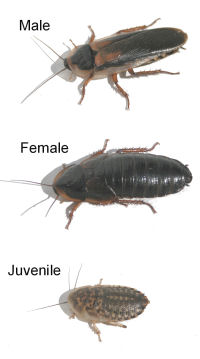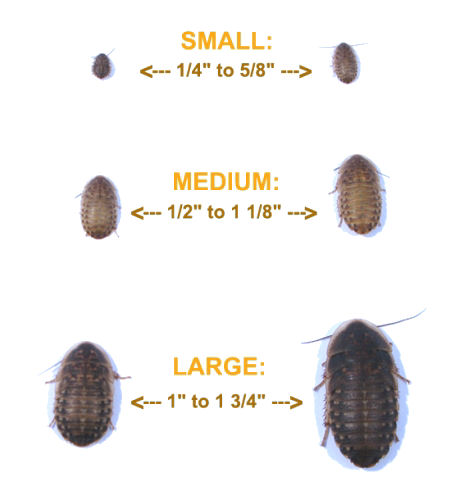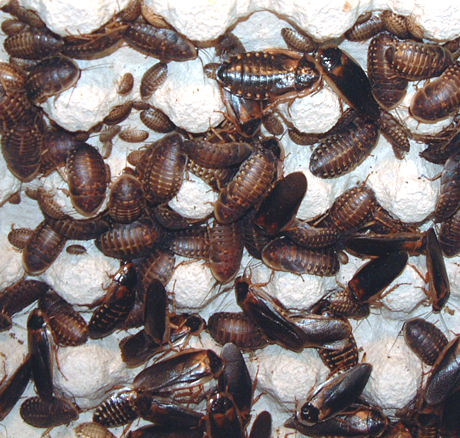
The Dubia cockroach (Blaptica dubia), also known as "Orange Spotted Roach" or "Guyana spotted cockroach", is a medium/large species of cockroach, measuring about 4.5 cm long. They are sexually dimorphic; the males have wings while the females have only tiny wing stubs. Adults are dark brown to black with somewhat lighter orange spot/stripe patterning sometimes visible only in bright light. Although the males have wings, they do not fly, they can hover 1-2 inches in the air. Neither adults or juveniles climb smooth surfaces, juveniles have been known to climb the silicon seals in aquariums. Dubias are prolific and give birth to anywhere between 20 to 40 live young in a month.
The Dubia cockroach is found in Central and South America. They are common from French Guyana and Brazil to Argentina.
Dubia cockroaches have become popular for feeding reptiles and amphibians because they are a high quality herp food source that is easier to raise than crickets.[2] Dubia are a meaty roach with a soft body which contain a much higher ration of protein to indigestible chitin compared to crickets. They breed in drier conditions than many other roaches and produce little odor. They are calm and easy to handle for feeding. They do not make any noise which is another reason they are becoming much more popular than crickets. Instead of having an escaped cricket forcing you to go "camping" at home, if you drop a roach they are easy to catch.
Compared to other roaches, they are exceptionally poor climbers and cannot climb glass or plastic;[3] they can, however, climb silicon used to seal fish tanks.
Compared to crickets, dubia roaches are quiet, don't smell, don't jump out of the enclosure, are less picky eaters, are more hardy. But they mature more slowly.
SEE ALSO
[1]
 The Dubia cockroach (Blaptica dubia), also known as "Orange Spotted Roach" or "Guyana spotted cockroach", is a medium/large species of cockroach, measuring about 4.5 cm long. They are sexually dimorphic; the males have wings while the females have only tiny wing stubs. Adults are dark brown to black with somewhat lighter orange spot/stripe patterning sometimes visible only in bright light. Although the males have wings, they do not fly, they can hover 1-2 inches in the air. Neither adults or juveniles climb smooth surfaces, juveniles have been known to climb the silicon seals in aquariums. Dubias are prolific and give birth to anywhere between 20 to 40 live young in a month.
The Dubia cockroach is found in Central and South America. They are common from French Guyana and Brazil to Argentina.
Dubia cockroaches have become popular for feeding reptiles and amphibians because they are a high quality herp food source that is easier to raise than crickets.[2] Dubia are a meaty roach with a soft body which contain a much higher ration of protein to indigestible chitin compared to crickets. They breed in drier conditions than many other roaches and produce little odor. They are calm and easy to handle for feeding. They do not make any noise which is another reason they are becoming much more popular than crickets. Instead of having an escaped cricket forcing you to go "camping" at home, if you drop a roach they are easy to catch.
Compared to other roaches, they are exceptionally poor climbers and cannot climb glass or plastic;[3] they can, however, climb silicon used to seal fish tanks.
Compared to crickets, dubia roaches are quiet, don't smell, don't jump out of the enclosure, are less picky eaters, are more hardy. But they mature more slowly.
The Dubia cockroach (Blaptica dubia), also known as "Orange Spotted Roach" or "Guyana spotted cockroach", is a medium/large species of cockroach, measuring about 4.5 cm long. They are sexually dimorphic; the males have wings while the females have only tiny wing stubs. Adults are dark brown to black with somewhat lighter orange spot/stripe patterning sometimes visible only in bright light. Although the males have wings, they do not fly, they can hover 1-2 inches in the air. Neither adults or juveniles climb smooth surfaces, juveniles have been known to climb the silicon seals in aquariums. Dubias are prolific and give birth to anywhere between 20 to 40 live young in a month.
The Dubia cockroach is found in Central and South America. They are common from French Guyana and Brazil to Argentina.
Dubia cockroaches have become popular for feeding reptiles and amphibians because they are a high quality herp food source that is easier to raise than crickets.[2] Dubia are a meaty roach with a soft body which contain a much higher ration of protein to indigestible chitin compared to crickets. They breed in drier conditions than many other roaches and produce little odor. They are calm and easy to handle for feeding. They do not make any noise which is another reason they are becoming much more popular than crickets. Instead of having an escaped cricket forcing you to go "camping" at home, if you drop a roach they are easy to catch.
Compared to other roaches, they are exceptionally poor climbers and cannot climb glass or plastic;[3] they can, however, climb silicon used to seal fish tanks.
Compared to crickets, dubia roaches are quiet, don't smell, don't jump out of the enclosure, are less picky eaters, are more hardy. But they mature more slowly.

